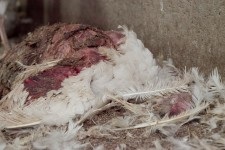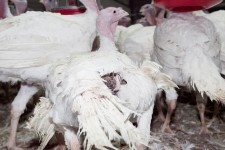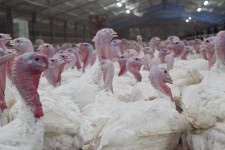- Overview
- Confinement
- Turkey poults
- Mutilation
- Artificial lighting
- Health Concerns
- Use of antibiotics
- Genetic alterations
- Muscle disorders
- Skeletal disorders
- Lame and injured birds
- Mortality rate
- Artificial insemination
- Health problems of breeders
- Slaughterhouse
- Turkeys: sentient and intelligent
- Conclusion
- References
Turkey Poults
When turkey poults first enter the sheds the lighting is dim and the artificial heating is kept high. Turkey poults are more difficult to raise than baby chickens, for example. Turkey poults are extremely interactive and have to have another 'figure' to lead them. For instance, they have inadequate eye-sight for the first week or so of their lives and rely on the guidance of their mothers to move around.
In factory-farmed conditions, poults are vulnerable to stress, heart attacks and starving to death because many are unable to find the food and water points without the guidance of their mothers.(10) Mortality in young birds is also related to a condition known as 'starve out' which is when birds enter a state of shock and stop eating. Management and environmental factors such as temperature, lighting levels, and food and water quality can also contribute to early mortality if the birds stop eating and/or drinking.(11) (See Figure 3 and 4).
Davis (2001) states that
'Turkeys are reared motherless on factory farms, in buildings in which the dimensions of time and space are reduced to monotonous extensions of toxic waste devoid of comfort, colors, and novelty, and which are filled with thousands of sick, dead, and dying birds stretching along a floor farther than the eye can see'(12)
 Figure 3: Turkey poults, approximately two to three weeks old being raised at a factory farm in Australia.
Figure 3: Turkey poults, approximately two to three weeks old being raised at a factory farm in Australia. Figure 4: A turkey poult, approximately two weeks old from a turkey factory farm in Australia. This poult died from respiratory problems (difficulty breathing) and had a severe injury on its head.
Figure 4: A turkey poult, approximately two weeks old from a turkey factory farm in Australia. This poult died from respiratory problems (difficulty breathing) and had a severe injury on its head.



